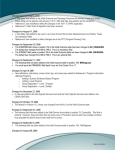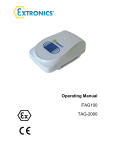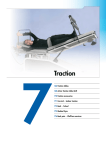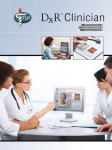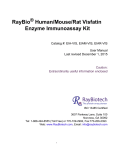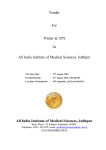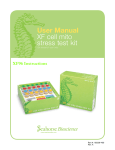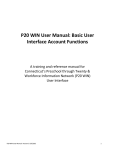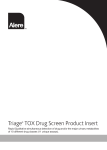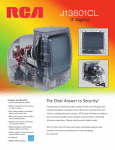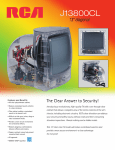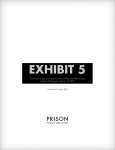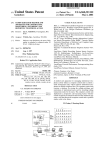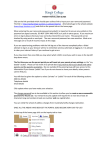Download Patient Safety System (PSS) - Correctional Managed Health Care
Transcript
UNIVERSITY OF CONNECTICUT HEALTH CENTER CORRECTIONAL MANAGED HEALTH CARE POLICY AND PROCEDURES FOR USE WITHIN THE CONNECTICUT DEPARTMENT OF CORRECTION NUMBER: P 1.01 Page 1 of 1 PATIENT SAFETY SYSTEM/PSS: DOWNTIME PROCEDURE Effective Date: 05/12/08 POLICY: In the event of interruption of service of the Patient Safety System/PSS CMHC staff shall ensure continuity of care by using a paper-based process. PROCEDURE: If unable to process orders using the Patient Safety System/PSS, staff shall revert back to manual paper requisitions (UCHC Radiology Requisition HCH 576/Laboratory Medicine Requisition HCH 812). DEFINITION: Patient Safety System Downtime is the interruption of service in the Patient Safety System/PSS. REFERENCES: CMHC Patient Safety System/PSS User’s Manual (Rev.3/2008). Approved: UCHC - CMHC Date: Title: CMHC Executive Director, Robert Trestman MD PhD _________________________________________ Title: CMHC Director of Medical Services, Mark Buchanan MD_______________________________________ Title: CDOC Director Health Services, Daniel Bannish PsyD _______________________________________ UNIVERSITY OF CONNECTICUT HEALTH CENTER CORRECTIONAL MANAGED HEALTH CARE POLICY AND PROCEDURES FOR USE WITHIN THE CONNECTICUT DEPARTMENT OF CORRECTION NUMBER: P 1.02 Page 1 of 1 PATIENT SAFETY SYSTEM/PSS: INMATE ADMISSION/QUICK ADMIT Effective Date: 05/12/08 POLICY: CMHC staff shall ensure that an established inmate health record (HR) exists in the Patient Safety System/PSS. All inmates admitted from the community to an intake facility and who will require orders for laboratory, radiology, or pharmacy services prior to the next routine OBIS feed (around 2:00 am), require the initiation of /or reactivation of a Patient Safety System/PSS HR. DEFINITIONS: An Inmate Admission is the creation of a new PSS HR for the initial incarceration of an individual to CDOC, or the new admission of a former inmate who has no established PSS HR (discharged prior to June 14, 2004). A Quick Admit is the reactivation of a previously established PSS HR. PROCEDURE: CMHC staff shall enter the inmate current incarceration date, facility, and housing location following the instructions in the PSS User Manual. REFERENCES: CMHC Patient Safety System/PSS Net User’s Manual (Rev.3/2008) Approved: UCHC - CMHC Title: CMHC Executive Director, Robert Trestman MD PhD Date: ______________________________________ Title: CMHC Director of Medical Services, Mark Buchanan MD _____________________________________ Title: CDOC Director Health Services, Daniel Bannish PsyD _________________________________________ UNIVERSITY OF CONNECTICUT HEALTH CENTER CORRECTIONAL MANAGED HEALTH CARE POLICY AND PROCEDURES FOR USE WITHIN THE CONNECTICUT DEPARTMENT OF CORRECTION NUMBER: P 1.03 Page 1 of 1 PATIENT SAFETY SYSTEM/PSS: TRANSFER OF INMATES Effective Date: 05/12/08 POLICY: CMHC staff at the sending facility shall update the Patient Safety System/PSS location information of any inmate who is transferred from one DOC facility to another or from a DOC facility to a Halfway House or from a DOC facility to an acute care facility. DEFINITION: A transfer is the manual process of changing an inmate location in the Patient Safety System/PSS. PROCEDURE: CMHC staff shall follow the instructions in the Patient Safety System/PSS User Manual to update an inmate location. REFERENCES: CMHC Patient Safety System/PSS User’s Manual (Rev. 3/2008). Approved: UCHC - CMHC Title: CMHC Executive Director, Robert Trestman MD PhD Date: ______________________________________ Title: CMHC Director of Medical Services, Mark Buchanan MD______________________________________ Title: CDOC Director Health Services, Daniel Bannish PsyD _________________________________________ UNIVERSITY OF CONNECTICUT HEALTH CENTER CORRECTIONAL MANAGED HEALTH CARE POLICY AND PROCEDURES FOR USE WITHIN THE CONNECTICUT DEPARTMENT OF CORRECTION NUMBER: P 1.04 Page 1 of 1 PATIENT SAFETY SYSTEM/PSS: PHYSICIAN/PRESCRIBER CO-SIGNATURES Effective Date: 05/12/08 POLICY: The University of Connecticut Health Center (UCHC), Correctional Managed Health Care (CMHC) requires all telephone orders placed in the Patient Safety System/PSS to have co-signatures documented. Physician /Prescriber electronic co-signature for telephone orders is required within 72 hours or, when a physician is not on site, during the next physician visit. The electronic co-signature will carry a date and time. PROCEDURE: The Physician/Prescriber co-signature function of the Patient Safety System/ PSS can be completed by following the procedure outlined in the CMHC Patient Safety System User Manual. REFERENCES: University of Connecticut Health Center Correctional Managed Health Care Policy and Procedure Manual, E 14.01 Prescriber Orders. CMHC Patient Safety System/PSS User Manual (Rev. 3/2008). Approved: UCHC - CMHC Date: Title: CMHC Executive Director, Robert Trestman MD PhD _________________________________________ Title: CMHC Director of Medical Services, Mark Buchanan MD ______________________________________ Title: CDOC Director Health Services, Daniel Bannish PsyD _______________________________________ UNIVERSITY OF CONNECTICUT HEALTH CENTER CORRECTIONAL MANAGED HEALTH CARE LABORATORY MANUAL FOR USE IN THE CONNECTICUT DEPARTMENT OF CORRECTION NUMBER P 1.05 Page 1 of 4 LABORATORY TEST ORDERING AND RESULTS REPORTING Effective Date: 11/24/08 POLICY: University of Connecticut Health Center (UCHC), Correctional Managed Health Care (CMHC) shall ensure for Connecticut Department of Correction (CDOC) inmates the required laboratory tests are ordered and the results from laboratory testing are available for review, and filed in the inmates’ health record. PROCEDURE: LABORATORY ORDERS: All CMHC Health Service Units with the ability to place laboratory orders electronically using the Patient Safety System (PSS) shall submit laboratory orders to the Department of Laboratory Medicine using the PSS. When ordered in the PSS, a hard copy of the laboratory order “Order Session Print”, will print on-site at the facility. The PSS generated laboratory order hard copy, “Ordered Session Print”, shall be filed in the inmate’s health record on top of the physician order sheet, right hand side. Once the laboratory results have been received, reviewed and filed, the hard copy of the “Order Session Print” shall be removed from the inmate’s record and shredded. All CMHC Health Service Units without the ability to place Laboratory orders through the Patient Safety System and those with the ability but are experiencing a “Downtime” or “interruption of service” with the PSS should place orders by the manual process of using a paper requisition, Form HCH – 812, Laboratory Medicine Requisition, see attachment. All information requested on the requisition shall be completed. The inmate's identification number shall be used and shall have the prefix I00 (capital I) to identify the referral source as CDOC. The identification number should contain nine (9) digits. For example,I00123456. Effective Date: 11/24/08 Revision Date: 06/30/10 NUMBER P 1.05 Page 2 of 4 LABORATORY TEST ORDERING AND RESULTS REPORTING Each requisition shall have the following information: CMHC Information Inmate Name Inmate Identification Number Requesting Physician Inmate Date of Birth Sex of Inmate Name of Inmate’s facility Health Service Unit Phone Number Date Drawn Time Drawn TECH ID RESULTS: Laboratory test results shall be available electronically in the Patient Safety System (PSS) Lifetime Clinical Record (LCR). Results shall be printed, reviewed, dated and signed by a prescriber, and filed in the inmate health record. All critical laboratory test results shall be reported to the facilities by the UCHC Laboratory staff as stated in their Department of Laboratory Medicine Policy: Reporting of Critical Values. Once the result has been authenticated, the Laboratory staff will immediately place a telephone call to the location of the patient as stated on the requisition form. The Laboratory staff will ask to speak to the requesting physician (as stated on the requisition form) or to a nurse working in the CMHC facility. The critical results shall be reported to a licensed care provider. A licensed CMHC care provider shall immediately notify a prescriber of the critical value and document the notification in the inmate health record. See attached Form HCH – 812, Laboratory Medicine Requisition See attached UCHC Laboratory Medicine Policy: Reporting of Critical Results Effective Date: 11/24/08 Revision Date: 06/30/10 NUMBER P 1.05 Page 3 of 4 LABORATORY TEST ORDERING AND RESULTS REPORTING University of Connecticut Health Center Correctional Managed Health Care Patient Safety System Lab Electronic Order Processing Workflow Quick Admit Patient Factors Process Flow Add On Orders print on Order Notice Orders entered in PSS Current Orders/Write Orders YES Add On Order Note: Orders entered into PSS display as ORDERED Note: Order is not sent over the interface to laboratory (LIS) system at this time NO 1) Fax Order Notice to UCHC Lab Central Processing (860.679.1401) 2) Call UCHC Lab Central Processing (860.679.2498) YES Sending facility contacts receiving facility to YES schedule procedure File Order Session Print or Order Notice in Inmates Paper Chart Will procedure be performed at a different CDOC location? NO **Note: PSS ad hoc reporting generates Worklist Siemens PSS generates CMHC lab tech Worklist list ** Internal - Custody work flow process Lab tech updates order collection time,indicates specimen & source, adds comments. Inmate arrives in facility stick lab CMHC lab tech Performs order in Siemens PSS. Order status displays as PERFORMED Note: Order is sent over the interface to laboratory at this point: Collection fields populate in LIS Labels print at stick lab printer: Zebra TLP 3844-Z Result document is routed to pre-defined facility network printer (medical unit/central nurse station) Specimen is collected Split lab label & tube types indicated on Lab Manifest Order status in PSS is updated to ‘Complete’ Effective Date: 11/24/08 Revision Date: 06/30/10 Internal Laboratory Department Work Flow Specimen (with label affixed) is delivered to JDH laboratory Note: Daily Lab Manifest is a page listing of patient specimens submitted by facility to JDH lab for the day. NUMBER P 1.05 Page 4 of 4 LABORATORY TEST ORDERING AND RESULTS REPORTING Approved: UCHC - CMHC Title: CMHC Executive Director, Robert Trestman MD PhD _________________________________________ Title: CMHC Director of Medical Services, Mark Buchanan MD ______________________________________ Title: CDOC Director Health Services, Daniel Bannish PsyD Effective Date: 11/24/08 Revision Date: 06/30/10 _______________________________________ DEPARTMENT OF LABORATORY MEDICINE REPORTING OF CRITICAL VALUES PRINCIPLE A critical value is a laboratory result which is at such variance with the established reference interval as to represent a pathophysiologic state that is life-threatening to the patient unless immediate action is taken. It is the responsibility of the laboratory to promptly communicate these results to a responsible individual, with appropriate clinical skills, who is in close proximity to the patient. The results of all critical values obtained from patients in John Dempsey Hospital are to be called by telephone to the patient care area as listed by the ADT (Admission, Discharge, Transfer) system. Critical value results obtained from outpatients must be called to the location identified on the test requisition. The laboratory’s obligation to speak to a responsible individual is the same for outpatients as it is for inpatients. Appropriate documentation must be entered into the LIS (laboratory information system). The test menu for which critical values have been assigned by the laboratory directors is attached to the end of this procedure. Any critical values reported by reference labs to the Department of Laboratory Medicine will be communicated to appropriate personnel by the procedure that follows. PROCEDURE Inpatients: 1. All critical value results must be repeated or confirmed by another method if possible (i.e. platelet estimate to confirm low platelet count). The time for repeat analysis or confirmation should not exceed 30 minutes. Since critical value results are indicative of a life-threatening situation, where immediate medical action should be taken, every effort should be made to verify/confirm the result as soon as possible. 2. After the critical value is authenticated, immediately place a telephone call to the location of the patient as stated on the laboratory test requisition form (i.e. ICU, ED, Surg 7, etc.). Ask to speak to the requesting physician or to the primary care nurse assigned to the patient or any other licensed provider. 3. If both the physician or nurse on the unit are not available, page the ordering physician or whoever is covering for that provider. If no one calls back, notify the supervisor or Lab Med faculty on call. 4. Relay the results to the recipient and have the recipient “read back” the results to assure accuracy. 5. Record the name of the recipient of the call, the telephone number called (if different from the telephone number in the pop-up screen), a brief description of the nature of the call (e.g., critical K to RN Jean, read back) into the LIS (see section entering call comments below). Outpatients: 8:30 AM to 5:00 PM (clinic hours) 1. Repeat the analysis to confirm the abnormal result within 30 minutes. Again, every effort should be made to provide the verified result as expeditiously as possible 2. Once the result has been authenticated, immediately place a telephone call to the location of the patient as stated on the requisition form (i.e. medical specialties, etc.). Ask to speak to the requesting physician (as stated on the requisition form) or to a nurse working in the clinic. If you get an answering service or voice mail, page the physician. If the physician does not respond to the page record his/her name in the appropriate section of the LIS and notify a the laboratory medicine faculty on-call for evening/night coverage. 3. Record the name of the recipient of the call and the telephone number called (if different from the telephone number in the pop-up screen) into the LIS (see section entering call comments below). 5:00 PM to 8:30 AM (non clinic hours): 1. Repeat the analysis or confirm the result using an appropriate confirmation test within 30 minutes. 2. Immediately place a telephone call to the page operator (679-2626) and ask for the physician covering the service. Inform the physician of the verified critical value result. 3. Document the name of the recipient of the call and the telephone number called (if different from the number in the pop-up screen) in the LIS (see section on entering call comments below). 4. If the name and telephone number of the physician covering the service cannot be obtained from the page operator, notify the laboratory medicine faculty on-call. If the physician identified by the page operator as covering the service refuses to accept responsibility for the result, record his/her name in the appropriate section of the LIS and notify the laboratory medicine faculty on-call. Entering Call Comments into the Laboratory Information System: As the call is being placed, open the call list window in the result entry portion of the LIS (see below). Record the name of the individual to whom the result was given. The LIS will capture the date/time/technologist initials. I. From bottom of Results Screen 2. Press ^C call/comments 3. Enter Y or press F2 to open the call list window. 4. With the call list window displayed, call the number of the ward as indicated (which is defaulted) or the number/page of the doctor entered in the order comment. Enter the following data in each applicable field: Called: (use this field to indicate the status of the call) Y The results are called in. N The results have been requested but are not yet called in. Y Information was added after the initial call was placed.** Y The call was attempted but not completed (i.e. the phone was busy, doctor paged but did not return call, nurse or physician not available, results faxed instead). ** This disposition is used when you need to add additional information. For example, if you page a doctor and he or she calls 10 minutes later, record the call back by first putting the Y sign in the "Called:" field. This will clear the message that was there and allow you to add additional information. After you have done that Press F12 to indicate that the call was completed. Person/Message: Enter the name of individual who received the critical value result as well as the telephone number to which the call was placed (if different from the number displayed in the call list window). Verification information must also be included. The LIS will automatically log the date and time of the comments. The technologist's password will automatically document the individual placing the call. 5. To see how many times the call was attempted, press the equal (=) key. 6. After entering the appropriate information, press F12 and Y to confirm entries. CRITICAL VALUES FOR CLINICAL LABORATORY TESTS Clinical Chemistry Units Low High ≥12.9 Serum calcium (adult and mg/dL <6.6 newborn) Serum ionized calcium mmol/L < 1.00 ≥1.55 ≥500 Serum glucose mg/dL < 50 ≥7.5 Serum phosphorus (inorganic) mg/dL <1.0 ≥160 Serum sodium mEq/L <122 ≥5.9 Serum potassium mEq/L < 2.8 ≥7.1 Serum potassium (newborn) mEq/L < 2.4 ≥8.0 Serum potassium (hemolyzed) mEq/L < 2.8 Serum bicarbonate mEq/L <12 ≥40 Serum bilirubin (total - newborn) mg/dL ≥15 Serum blood urea nitrogen mg/dL ≥120 CSF glucose mg/dL < 40 ≥200 CSF protein mg/dL ≥70 Acetaminophen mg/L ≥200 Amikacin peak μg/mL ≥36 Amikacin trough μg/mL ≥11 Carbamazepine mg/L ≥15 Digoxin ng/mL ≥4 Ethanol mg/dL ≥300 Gentamicin peak μg/mL ≥11 Gentamicin trough μg/mL ≥2.1 Lithium mmol/L ≥2.0 Phenobarbital mg/L ≥60 Phenytoin mg/L ≥21 Salicylate mg/dL ≥31 Theophylline mg/L ≥21 Tobramycin peak μg/mL ≥11 Tobramycin trough μg/mL ≥2.1 Valproic acid mg/L ≥101 Vancomycin peak μg/mL ≥41 Vancomycin trough μg/mL ≥21 Units Low High Hematology Blood hematocrit % < 21 ≥60 Blood hemoglobin g/dL <7 ≥20 Blood total leukocyte count (WBC) WBC/uL ≥100,000 Blood platelet count Cells/uL < 20,000 ≥1,000,000 Plasma prothrombin time seconds 24 Plasma partial thromboplastin time seconds ≥110 Fibrinogen mg/dL ≤100 > 1000 Microbiology Any positive culture of normally sterile body fluid. CSF: Gram stain result, antigen result, or positive culture. 08














